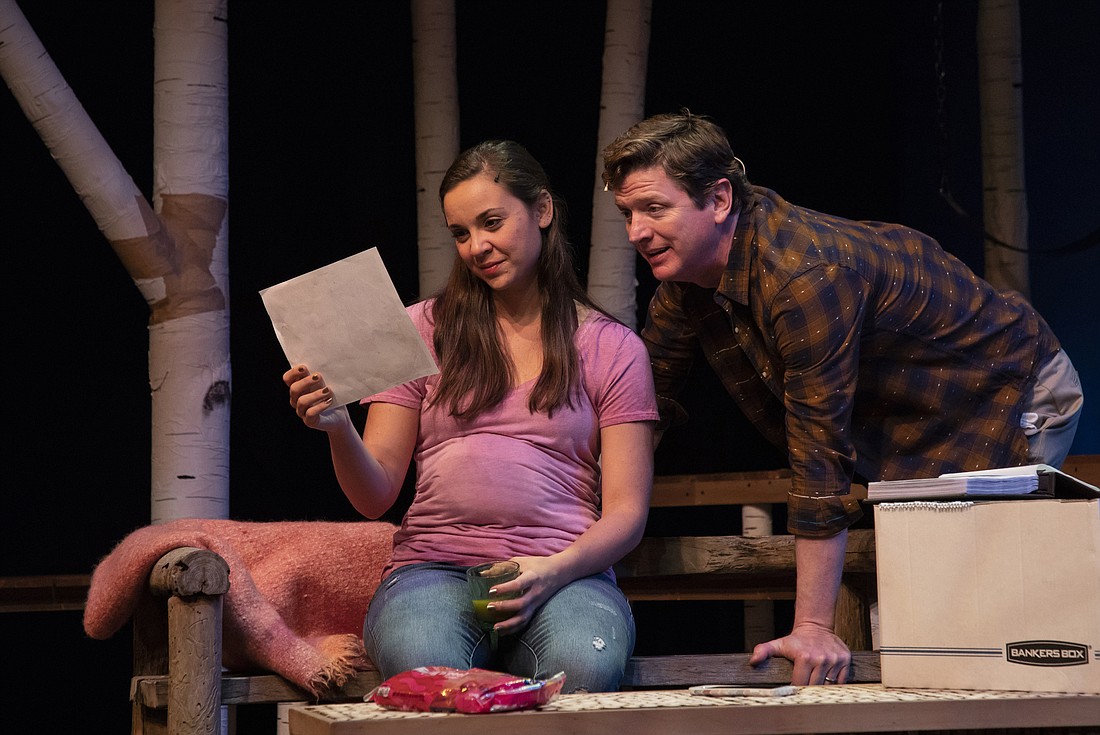- July 15, 2025
-
-
Loading

Loading

The urge to fill the world with children is the driving force behind Mark St. Germain’s “Wednesday’s Child,” which is now premiering at Florida Studio Theatre. The playwright explores assorted permutations of pregnancy and adoption. Ah, sweet mystery of life! But St. Germain’s play is a murder mystery. And it’s not so sweet.
The play opens with a dead narrator along the lines of “Sunset Boulevard.” The recently deceased Becca (Brooke Tyler Benson) wanders around an otherworldly forest and wonders who murdered her. You discover that, before her untimely death, Becca was a struggling college student. She agreed to be a surrogate mother for Susan (Rachel Moulton) and Martin (Duke Lafoon) to help pay for her education. Becca’s first pregnancy ends in a miscarriage. She tries again. It seems to be going well — until her brutal murder. Two detectives get on the case — an old Irish cynic (David Smilow) and a young, ambitious Latina (Alicia Taylor Tomasko). The play shifts between their investigation in the present and flashbacks to events leading up to the crime. The shocking truth is ultimately revealed.
This narrative shifts back and forth between a prosaic police procedural and a mystic sense of transcendent truths. The opening pretty much tells you that there is an afterlife, but what’s the point of this life? Ah, that’s the big mystery. St. Germain symbolizes it with references to the “Madonna of the Galilee,” a non-Christian mosaic of a female figure in a fourth-century Roman villa in Galilee.
Kate Alexander’s direction puts the pieces together in the detective story. She also hints of a profound revelation about life, the universe and everything. Need answers? You’ll find out who killed Becca. But life’s riddle will remain unsolved.
St. Germain’s moody mystery play transpires with some first-rate acting. Moulton’s Susan designs window displays (suggesting an obsession with keeping up appearances). Lafoon’s Martin is an archeologist (hinting at a desire to dig up buried truth.) They deliver great performances for their often-unsympathetic characters.
Tyler Benson’s Becca is bright and bubbly — and simultaneously cold and calculating. Her character’s often unlovable, too. The same applies to Heather Michele Lawler's Dr. Sutton —who comes out of nowhere as a blast from Becca’s past. But a few sympathetic characters balance things out. As the two likeable detectives, Tomasko and Smilow dance around the tired tropes of a police procedural. They lampshade the notion of good cop/bad cop. They don’t entirely escape it, though they’re always entertaining. Susann Fletcher delivers a great performance in her few scenes as Molly, an aging hippy lawyer, still fighting the good fight for social justice.
St. Germain’s mystical tale of fertility and futility unfolds against Isabel and Moriah Curley-Clay's suitably haunting set — a forest of blasted trees straight out of Dante’s “Inferno” where Becca’s spirit seems trapped. Susan Angermann’s costumes suit both the living and the dead. They offer a handy shorthand to the characters’ personalities being too obvious.
There’s a lot to like here. I was constantly impressed by the playwright’s command of dialogue, character and scene construction. But despite all that high-voltage talent, “Wednesday’s Child” still feels like a draft. What’s the problem?
That’s a mystery, too. But I think it boils down to a disconnect between idea and execution.
This play takes the form of a murder mystery. I suspect the playwright’s heart isn’t in it. He’s more concerned with the underlying philosophical issues than connecting the whodunit dots. His mystery is basically an excuse for the big, scary ideas. Specifically, ideas about humanity’s relentless biological drive to populate the world with miniature replicas of ourselves.
St. Germain questions that drive. Bob Dylan defined the ultimate fear as: “the fear to bring children into the world.” The playwright evokes that fear at several points. And seems unsympathetic towards those who defy it. He suggests that it’s a rotten world after all. Is it fair to bring children into it?
That question is bigger than the mechanics of surrogate pregnancy. It applies equally to adoption. That might seem like a logical unselfish alternative for the infertile. Without giving too much away, St. Germain demolishes that option, too. So what’s the answer?
The playwright ducks the issue with an appeal to mysticism. After solving the murder mystery, he returns to mystery of life. The final scene is a powerful image of the “Madonna of the Galilee,” a tessellated mosaic comprised of myriad glass fragments. She symbolizes the big picture. Our feeble human minds can never grasp it. Perhaps. But playwrights should at least try.
Especially when they raise the big questions.